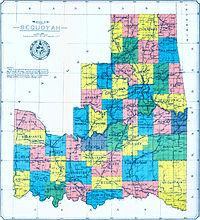State of Sequoyah
| State of Sequoyah | |
|---|---|
 The State Seal | |
 Proposed State of Sequoyah | |
| Constitutional convention: | August 21, 1905 |
| Convention President: | Pleasant Porter |
| Vice President(s) | William C. Rogers, Cherokee William H. Murray, Chickasaw |
| Statehood | |
| Approved 1905 by referendum. Denied by United States Congress. Became part of State of Oklahoma in 1907. | |
The State of Sequoyah was a proposed state to be established from the Indian Territory in the eastern part of present-day Oklahoma. In 1905, faced with proposals to end their tribal governments, Native Americans of the Five Civilized Tribes in Indian Territory proposed to create a state as a means to retain control of their lands. Their intention was to have a state under Native American constitution and rule.[1] The proposed state was to be named in honor of Sequoyah, the Cherokee who created a writing system in 1825 for the Cherokee language.
Background

From 1890, the land that now forms the State of Oklahoma was made up of the "Twin Territories:" Oklahoma Territory to the west, and the Indian Territory to the east. The Indian Territory, as its name suggests, had a large Native American population, but European-American settlers had also continued to arrive. The territory had been reduced by required land cessions after the Civil War; land runs; and through other treaties with the United States. In the 1900 US Census, Native Americans composed 13.4 percent of the population in the future state. In 1905, the Five Civilized Tribes had a total of about 60,000 persons in the Indian Territory out of a total population of 600,000.[2]
The Native American movement to secure statehood for the Indian Territory began in 1902 with a convention held in Eufaula. It consisted of representatives of the Five Civilized Tribes. The representatives met again in 1903 to organize a constitutional convention, to be held in 1905.
The constitutional convention
The Sequoyah Constitutional Convention met in Muskogee, on August 21, 1905. General Pleasant Porter, Principal Chief of the Creek Nation, was selected as president of the convention. The elected delegates decided that the executive officers of the Five Civilized Tribes would also be appointed as vice-presidents: William C. Rogers, Principal Chief of the Cherokees; William H. Murray, appointed by Chickasaw Governor Douglas H. Johnston to represent the Chickasaws; Chief Green McCurtain of the Choctaws; Chief John Brown of the Seminoles; and Charles N. Haskell, selected to represent the Creeks (as General Porter had been elected President). Muscogee journalist Alexander Posey served as secretary.[3]
The convention drafted a constitution, drew up a plan of organization for the government, put together a map showing the counties to be established, and elected delegates to go to the United States Congress to petition for statehood. The convention's proposals were put to a referendum in the Indian Territory, where they were overwhelmingly endorsed.
Failure to obtain statehood
The delegation received a cool reception in Washington. Republican politicians, fearing the admission of two more Democrat states, with a relative increase in political power, put pressure on the U.S. President, Theodore Roosevelt. He ruled that the Indian and Oklahoma territories would be granted statehood only as a combined state.[4]
The hard work of the Sequoyah State Constitutional Convention was not entirely lost. When representatives from Indian Territory joined the Oklahoma State Constitutional Convention in Guthrie in 1906, they brought their constitutional experience with them. The Sequoyah Constitution served in large part as the basis for the constitution of the State of Oklahoma, which was admitted in 1907 after the merger of the two territories.[citation needed]
See also
- Hitchcock County, Sequoyah
- List of United States territories that failed to become states
- Pushmataha County, Sequoyah
Notes
- ^ "Museum of the Red River - The Choctaw". Museum of the Red River. 2005. Retrieved 4 August 2009.
- ^ "THE STATE OF "SEQUOYAH."" (PDF). The New York Times (Archive). 5 October 1905. Retrieved 4 August 2009.
- ^ Wilson, Linda D. "Posey, Alexander Lawrence (1873—1908)," Encyclopedia of Oklahoma History and Culture, 2009. Accessed March 1, 2015.
- ^ "147 – The Stillborn State of Sequoyah". Strange Maps – An Atlas of Cartographic Curiosa. 14 July 2007. Retrieved 4 August 2009.[dead link] [dead link]
